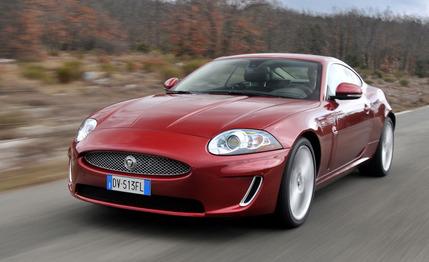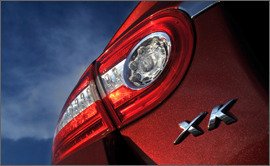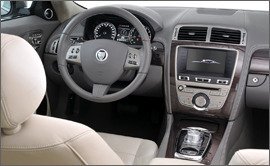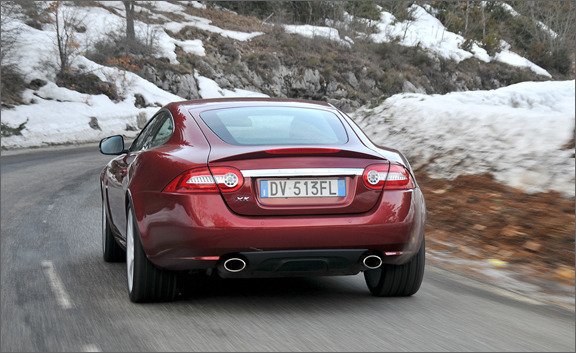 Short Take Road Test
Short Take Road Test
Jaguar is confident it got the XK right. Proof is on the order sheet, where there are almost no options. The factory is 13 color choices away from churning out an endless parade of identical cars. The only options are added-cost paint, a pair of wheel upgrades, a black headliner, a heated windshield, HD Radio, and the Advanced Technology package, which bundles adaptive headlights (which you might want) with adaptive cruise control (which you absolutely do not).
Then again, if a carmaker includes everything as standard, there’s nothing left to ask for. On the cheapest XK you can buy are navigation, satellite radio, 16-way power seats—heated and cooled—a heated steering wheel, keyless entry and go, and a 525-watt Bowers & Wilkins stereo with an in-dash six-disc changer and a USB input. The interior on our test car, which was beyond reproach and filled with wood and leather so sumptuous you want to lick them, didn’t cost an extra nickel. We were positively floored when we looked at this car’s window sticker and saw not a single option listed. Of course, a price of $83,000 will also floor a lot of people.

Entry-Level Excellence
This Jaguar’s standard excellence extends beneath that long, elegant hood, too. But even cars that get it right on the first go have some room for improvement. So for 2010, the former base engine—a 300-hp, 4.2-liter V-8—was replaced by a direct-injection, 5.0-liter eight with variable valve timing and a variable-geometry intake manifold, generating a stonking 385 hp at 6500 rpm and 380 lb-ft at 3500. In addition to shuffling the XK about effortlessly, turning in a 5.0-second 0-to-60 flick, and bellowing through the quarter in 13.5 at 107 mph, the 5.0 sounds marvelously unrestrained, nearly out of place in a car so elegant. We say “nearly” because ensuring other people know you’re better than them is part of the Jaguar allure, no? The engine’s tremendous flexibility is reflected in its passing-acceleration times: 30 to 50 mph in 2.5 seconds, 30 to 70 mph in 3.6. This is a car for people who are going places and are bent on getting there immediately.
Behind that engine is the only transmission available, a six-speed automatic (if you’re hoping for more griping about the rotary shifter, look elsewhere). Paddles on the back of the steering wheel are standard, of course, and each one has a single assigned task: The right upshifts, and the left downshifts. The transmission responds instantaneously, and on downshifts, it rev-matches so aggressively it’ll probably fool a lot of automatic-driving bystanders.

The Jag also feels plenty sporty on a winding road. The steering is weighty but without being crass or overly sporty. Feedback is muffled somewhat—just enough so that it doesn’t trouble the driver. The same is true of the handling. Toss the XK into a bend, and it is balanced and planted but without being so stiff as to ever upset a passenger. The base XK rides on the same suspension as the more sporting XKR, which helps explain the cars’ essentially identical skidpad figures: 0.92 for the XKR versus 0.91 for the XK seen here. Braking from 70 mph to 0 is similarly similar, at 163 feet for the XK and 160 for the XKR.
The one demerit the cars share is the size of the interior. Although sumptuous, the space is a bit confining. Then again, that’s the British tradition—didn’t the colonials bail because they found the Old Country too stifling? The XK wouldn’t have to be so snug if it weren’t for that vestigial rear seat, though. Nobody is going to fit back there, and even if you find someone who does, the sleek roof and the high beltline leave them a nose-high pillbox slot for a window. Just ditch it, we say. Even if the resultant space increase is minimal, it’s still an increase, and any bump in insurance rates from ditching two seats would be irrelevant to people shopping the XK.
Seriously, Fix the Electronics, Already
We were also disappointed—but not surprised—to find a few electronics issues with our Jaguar. One staffer slowed to maneuver through some bumps in the road and emerged on the other side to find that the transmission had disengaged. The twirling tranny knob still pointed at D, but the D was blinking. He rotated the knob to sport, which did nothing, and then to neutral, which did nothing. So he stopped, put the car in park and back in drive, and was only then able to continue on his way.

Later, on a freeway slog, we noticed that bumps would occasionally cause the cruise control to quit. What made this even stranger was that it didn’t seem to be the biggest impacts that did it—just random expansion joints here and there. Although moving our thumb to the “resume” button is easy enough, that’s not quite the point. The cheapest cars on the road don’t have problems like this; it’s not okay for a Jaguar to.
Those, though, are our only complaints. The XK is a stunning car to look at, to be inside, and to drive. It feels special and substantive, and everything that makes it so is standard. The fact that the $96,000 XKR merely adds more power—but not major chassis, transmission, or interior upgrades—is proof. The only way Jaguar saw fit to make the everyday XK better was to fortify it with this bigger engine. We agree. (And if somebody could permanently banish the electrical gremlins, we’d agree to that, too.)